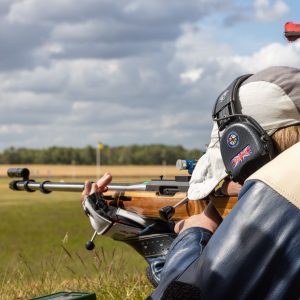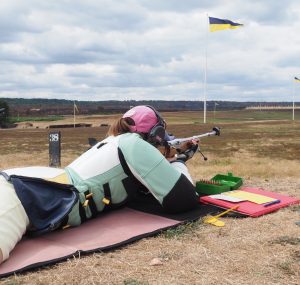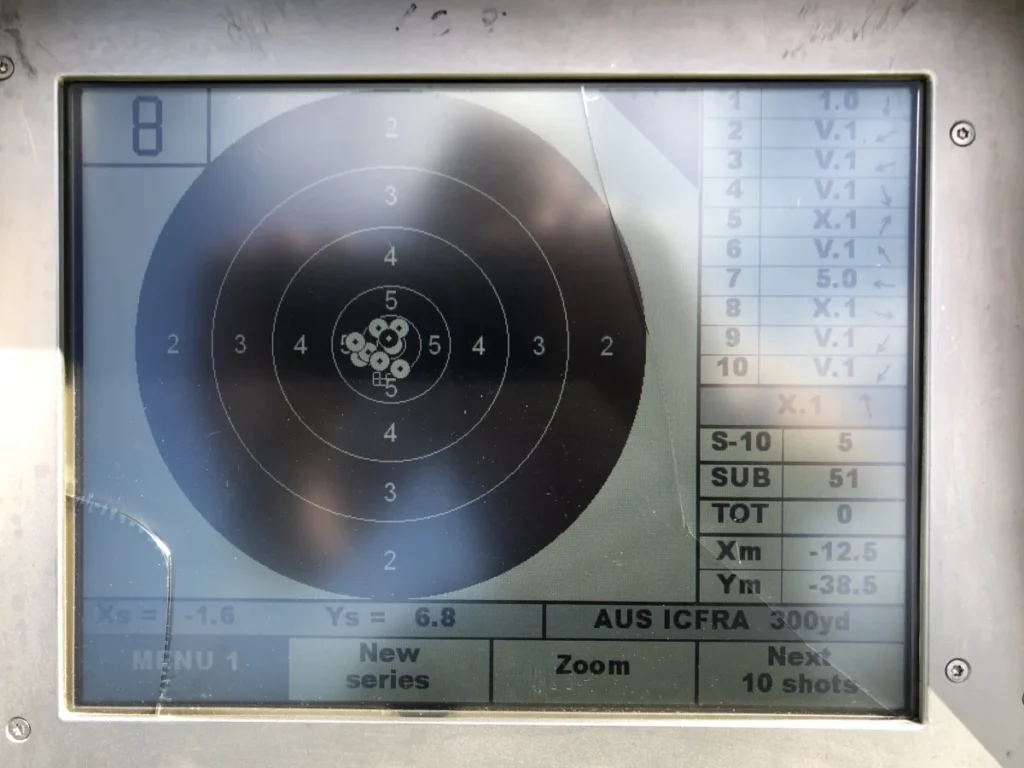About Target Rifle Shooting
The objective in individual and team shooting is simple: hit the middle more often than anyone else in a given time, with a given number of shots.
Type of Rifle

The rifle itself is bolt action and fires individual bullets over a distance of 300 to 1000 yards. The bullet has a diameter of .308 inches. Other disciplines will shoot at different distances, and will have different rules governing equipment, ammunition etc.
In fullbore rifle the firearm must be held up by the competitor (with the aid of a sling which you attach to the rifle and your shooting jacket) and competitors are not allowed to aim using telescopes. At longer ranges this can prove quite tricky!
Competing

All competitors fire their rifle in the “prone” position (or lying down on their front). Other disciplines will shoot in 3 positions (prone, kneeling and standing) but fullbore rifles have more kick so you need to be lying down for it.
Fullbore shooting is both an individual and a team sport. Individually, the shooter is responsible for both firing the rifle and taking into account external factors such as wind.
Adjusting for Wind

As fast as a bullet flies (around 3000 feet per second) it will still be blown left and right by the wind (as it can take up to a second to reach the target). With the aid of wind flags on the range, shooters will adjust their sights to compensate for shots being blown off centre.
Team Matches

In team matches, for example when competing for the GBRT, roles are specialised, where you have dedicated shooters and wind coaches who will be on the firing point with the shooter, watching the flags and changing the sights for you.
Ammunition
History

Target Rifle shooting has experienced a lot of change over the last 40 years. Several factors have contributed to this, firstly with the design and development custom-made target rifles, alongside improvements to the manufacture of barrels and aperture sights.
Another area seeing significant improvement is bullet design and the consistency of grouping from the bullets we use. There are many brands available who produce excellent and consistent bullets. The NRA of the UK issues ammunition in its major competitions and this is currently provided by the Lithuanian manufacturer, GGG.
Hand-loading for Accuracy

GBRT however will tend to make their own ammunition as “hand-loading” and, when done correctly, is proven to improve accuracy. International teams weigh and measure out exactly the right amount of each component and tailor loads to individual rifles and barrels.
A quick calculation of the time required to make the requirement of about 20,000 needed for a touring team gives a figure of about 150 hours, or 4 working weeks! This goes to show the dedication GBRT put towards achieving the best performance they possibly can.
Targets
The target is as you would expect – a “bullseye” is in the middle with larger concentric circles around it. At every distance the layout is the same, except the circles are larger the further back you go. If you’re lucky enough to hit a “bullseye” you score 5 points, with the next rings being the “Inner” (4 points), “Magpie” (3 points), “Outer” (2 points) and simply “Hit” for 1 point.
V-bull
As shooting technology improved, there became the need to separate – or tie-break – those who had got the maximum score. Thus the “V-bull” was created, which is a smaller ring within the bullseye. Hitting this ring still scores 5, but if a competitor scores the same as someone else, the person with the most “V-bulls” is the winner.


ICFRA
As GBRT competes internationally the target dimensions will sometimes change. For example, the World Long Range Championships are fired under ICFRA (International Confederation of Fullbore Rifle Associations) rules. In these matches the bulls-eye radius at 1,000 yards is 10 inches and the v-bull line is just 5 inches from the centre!
Marking
Whilst shooters and coaches are concentrating on shooting, they could not compete without the markers at the far end of the range.
The Butts

The area where the targets are is called “the butts”. It is a long line of targets, (usually) with a large sandbank behind it for the bullets to fly into. Markers stand in a long concrete gallery, some 8 feet below ground level, open to the elements on one side but covered by a concrete parapet.
In the USA, the shooters take it in turns to go down to the butts and mark the targets, however in Canada and the UK we rely on professional paid markers.
Marking the Shot
Markers can hear the crack of the bullet passing overhead and see the splash in the sandbank opposite. Looking up, hopefully, a tiny shot hole has appeared in the paper target. The target is then pulled down and a small spotting disk inserted into the hole. Along the bottom of the target, the scoring paddle indicates the value of the shot. The old hole is patched up and the target is raised for the next shot. Those back on the firing point can then see where the shot has gone on the target.
Marker Paddles






Electronic Future

Electronic targets are becoming increasingly popular as, despite the initial cost, feedback is instant and there is no need to employ markers or for competitors to mark targets. As the accuracy and reliability of electronic targets improves we anticipate they will be approved for use in international competition in the future.
